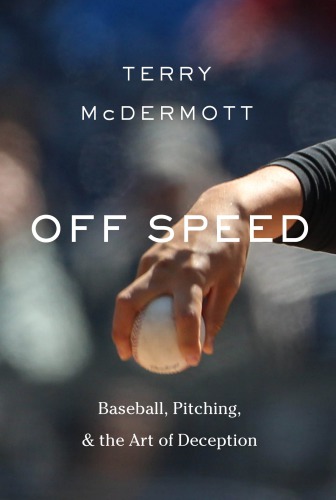
Off Speed
Baseball, Pitching, and the Art of Deception
کتاب های مرتبط
- اطلاعات
- نقد و بررسی
- دیدگاه کاربران
نقد و بررسی

December 12, 2016
Blending memoir with a baseball fan’s musings, McDermott (Perfect Soldiers) offers entertaining and wistful notes on the craft of pitching. Focusing on one pitcher, Seattle Mariners hurler Felix Hernandez, and one game between the Mariners and the Tampa Bay Rays on August 15, 2012, McDermott discusses various pitches—including the spitball, curveball, fastball, sinker, and knuckleball—and how they developed. He introduces pitchers who invented and excelled at certain pitches, such as Arthur “Candy” Cummings, who first developed the curveball, and R.A. Dickey, today’s most active knuckleball pitcher. McDermott deftly points out that the best pitchers are so practiced at the art of deception that they’re able to hide from a batter which pitch is coming even after the pitch has been released. He writes that the most common way for pitchers to throw a fastball that moves differently than the batter expects is to throw one that sinks. McDermott demystifies baseball, illustrating the game’s “secret beauty” from being built over a very long time. The chapters are sometimes repetitive and he refers to the New York Yankees as “Yankee.” These are enjoyable fan’s notes that might have been better published as a series of articles.

February 1, 2017
Former Los Angeles Times national reporter McDermott (101 Theory Drive: A Neuroscientist's Quest for Memory, 2010, etc.) changes pace with a book about baseball focused on the craft of pitching.The author is an avid fan of the Seattle Mariners, so he constructs his taxonomy of pitching around the perfect game pitched by Mariners' ace Felix Hernandez on Aug. 15, 2012. In a variety of asides, the author relates how growing up in small-town Iowa offered the foundation for his romance with baseball. (The author opens with a mention of Field of Dreams.) The chapters often veer off into nostalgia, sometimes featuring searing insights into rural life during the 1950s and '60s and other times coming off as trite. When McDermott focuses on Hernandez's perfect game, he provides an effective blow-by-blow account. The author relies on the box score from that day, news coverage of the game, and interviews with major leaguers, including Hernandez himself. In the sections in which McDermott writes about the evolution of specific pitches--e.g., traditional fastball, two-seam fastball, four-seam fastball, cutter, curve, slider, knuckleball, changeup, sinker, screwball, forkball, and the now-illegal spitter ("a pitch to which a foreign substance has been applied, causing the pitch to drop suddenly as it approaches home plate")--he also offers some brief digressions regarding baseball history in general. At times, McDermott makes pronouncements about the most talented pitchers that might be deemed controversial by some baseball scholars and fans--did Sandy Koufax throw the best fastball and the best curveball ever?--but the narrative is filled with passion and insight into how the game's measured pace can seem both out of touch with fast-paced contemporary life and a temporary corrective to that fast pace. The book will likely bore or baffle those not already passionate about baseball, but it will please die-hard fans.
COPYRIGHT(2017) Kirkus Reviews, ALL RIGHTS RESERVED.

April 1, 2017
Hall of Fame pitcher Warren Spahn famously said that hitting is timing and pitching is upsetting timing. How players are able to achieve that is mystifying to even the most astute baseball fans. Pitching has evolved far more rapidly than any other position, especially the variety of pitches thrown. McDermott (Perfect Soldiers) explores this evolution in his latest work, which is structured around the names of well-known pitches, such as the fastball, the curve, and the knuckleball. However, there are two other recurring narratives: memories from the author's childhood and personal life, and an inning-by-inning recount of Felix Hernandez's perfect game thrown on August 15, 2012. While the book is ostensibly about pitching, McDermott's intimate asides can be lengthy. Fortunately, his stories are engaging and add warmth and personality, making this work more accessible then Robert Adair's The Physics of Baseball. VERDICT Providing both insight into the art of pitching and a memoir on the role of the game in the life of a baseball fan, this work will be enjoyed by all lovers of the sport.--Brett Rohlwing, Milwaukee P.L.
Copyright 2017 Library Journal, LLC Used with permission.

Starred review from March 1, 2017
After facing Dodgers ace Sandy Koufax, outfielder Richie Ashburn marveled: Either he throws the fastest ball I've ever seen, or I'm going blind. Reflecting on the various ways that pitchers blind batters, McDermott enriches a carefully detailed account of the perfect game Felix Fernandez pitched against Tampa in August 2012 with fascinating digressions on the blinding speed of the fastballa speed Hernandez shared with Koufaxand on the deceptive finesse of the curveball, the sinker, the splitter, the cutter, the knuckleball, and even the spitball. Not all readers will welcome a physics lesson on how the Magnus force accounts for a sinker's maddening dive, but what baseball fan will not relish the stories of how Arthur Candy Cummings learned to throw a curve by throwing clamshells as a boy; of how Greg Maddox suckered Dave Martinez with a bases-loaded, full-count changeup well out of the strike zone, of how Joe Niekro mystified Willie Stargell with a knuckleball that flew like a butterfly with hiccups ? What lover of the game will not delight in McDermott's field-of-dreams nostalgia for the baseball he played and watched growing up in his small Iowa hometown? No one passionate about America's national pastime will leave these pages disappointed.(Reprinted with permission of Booklist, copyright 2017, American Library Association.)

























دیدگاه کاربران